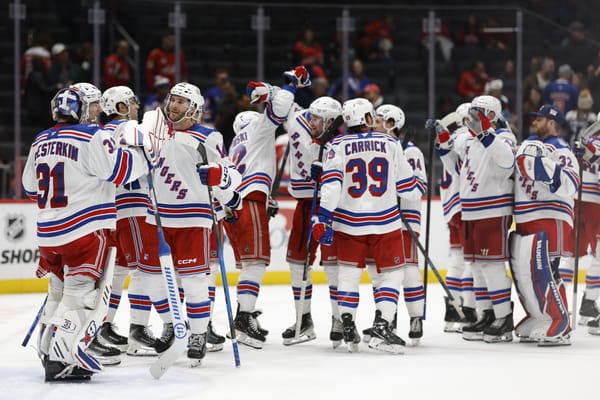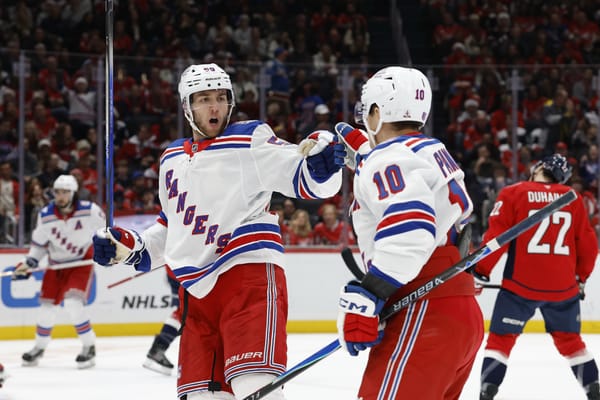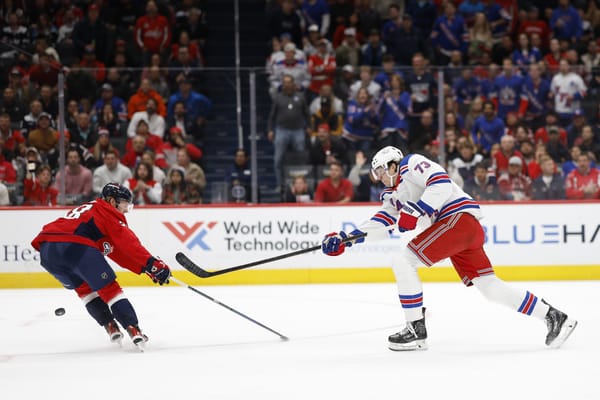Nils Lundkvist Making Most of Early Opportunity in Swedish Hockey League
Other prospects made names for themselves during the 2018-19 season. Now, the former first-round pick is catching up to the pack.
The 2019-20 season is paramount to the development of Nils Lundkvist. It’s not that the previous season went terribly for him. All things considered, 10 points in 41 games is fairly good production for an 18-year-old, two-way defenseman in the Swedish Hockey League.
But compared to fellow 2019 2018 first-round picks Vitali Kravtsov and K’Andre Miller, who had breakout campaigns and thrust themselves into top prospect discussions around the NHL, Lundkvist’s post-draft season was modest. For the most part, the cause was circumstantial rather than his own doing. His team, Luleå, were arguably the best in the SHL last season and had a crowded defensive corps.
The teenager, who would have played consistent minutes on nearly any other team in Sweden, found himself outside Luleå’s top-six and averaged under 13 minutes per game. At times, he’d go entire games with nothing more than a few token shifts as a fourth-line winger.
While Lundkvist was fine at the World Junior Championships, his play was not particularly notable as to change the complexion of an altogether unremarkable post-draft season. On its own, it was a perfectly passable showing, but he’ll need to take it to a higher level in 2019-20 in order to maintain credibility as a first-round caliber prospect.
The early returns have been positive. One of Luleå’s incumbent top-pairing defenseman, Carolina prospect Jesper Sellgren, enjoyed a prolonged stay at Hurricanes’ training camp. Luleå have trusted a stronger, more mature Lundkvist to fill the void, and he’s rewarded them with superb play. The 19-year-old is averaging 22:31 minutes of icetime through six games and his six points is second among all SHL defensemen. What’s even better is that all six points were at even strength, and no other SHL defender has registered more than four.
Nils Lundkvist ger Luleå ledningen 3-2, framspelad av Isac Brännström. #SHL #LHF #NYR pic.twitter.com/e9JIxX2ghL
— Anton Johansson (@antonj85) September 28, 2019
Granted, his offensive contributions have been somewhat passive as he’s not been a major catalyst on the majority of his points to date. His production is not itself the indicator of his improved play, but rather a byproduct of what he has done well. Lundkvist is playing a robust two-way game for Luleå, moving the puck up the ice and in the offensive zone with efficiency, if not flair. On the defensive end, he is not only dependable in his coverage, but it’s clear that he hit the gym in the summer. He has always been willing to play with bite, but now he has the strength to more effectively leverage his body in board battles and one-on-one situations.
Nils Lundkvist... good defenseman and strong boy. #NYR pic.twitter.com/CBUxBxKhun
— Alex Nunn (@aj_ranger) September 26, 2019
Lundkvist has a 54.04% Corsi For Percentage, meaning that Luleå get a healthy majority of the shot attempts at even strength when he is on the ice. Comparatively, Tobias calculated that Luleå’s Corsi For Percentage is 3.40% lower when he is off the ice. It’s worth noting, too, that Lundkvist has a goal and three assists in four Champions Hockey League games.
10 points in 10 SHL and CHL games for Nils Lundkvist to start this season. His puck distribution from the back has driven a lot of Luleå's early play. Defense consistently excellent. Can think of two bad plays he's made but both were recovered well. #NYR
— Alex Nunn (@aj_ranger) September 29, 2019
It is still very early in the season, and Lundkvist has his work cut out for him. The previously mentioned Sellgren has returned to Luleå, and Lundkvist will be in a constant battle for playing time. He’ll be trusted with a major role on Sweden’s World Junior team as well. It’s unlikely that Lundkvist keeps up this torrid offensive pace, but continuing to play a productive two-way game for 18-22 minutes a game the length of the season would firmly entrench him as a high-caliber prospect.
Lundkvist is not anywhere close to the best young player in the Rangers’ organization — we had him ranked eighth in our top-24 U24 rankings in July — but in certain ways his importance to the organization is higher than it shows at face value. As mentioned during the preseason, the Rangers’ situation at right defense with Jacob Trouba, Tony DeAngelo, and Adam Fox is untenable. All three are heavily offensive-minded, which is a major tactical dilemma. Even if the coaching staff solves that puzzle, the salary cap will inevitably force at least one of those three out of the picture in the next few years.
Lundkvist not only represents the team’s best option as a theoretical replacement when that time comes, but close to their only internal solution. Joey Keane has NHL upside but is a toss-up at best and probably peaks as a third-pairing defenseman. Beyond him, the cupboard is barren on the right side. Long-shot Hunter Skinner is the only other relevant right-handed defenseman in the system.
Given the absence of alternatives, the Rangers really need Lundkvist to continue on this trajectory. He’s not an elite prospect, nor a particularly exhilarating player to watch, but it’s fair to imagine him as the steady #3 defensemen every head coach begs his GM to acquire.




